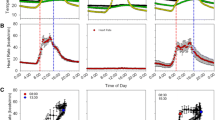Abstract
When faced with periods of food scarcity, an endothermic organism can use a variety of mechanisms for achieving a positive energy balance, or at least a steady state, in which energy intake compensates metabolic costs of survival. In general these mechanisms can be described as followed:
-
1)
Changes in foraging behavior should increase the efficiency of searching for food and/or the utilization of detected sources.
-
2)
Decreased deep body temperature (Tb) and decreased heat production lower energy output, especially the costs of endother-mia, in mammals and birds.
-
3)
Birds can decrease their heat loss to the environment by erection of plumage or by resting at warm places.
Access this chapter
Tax calculation will be finalised at checkout
Purchases are for personal use only
Preview
Unable to display preview. Download preview PDF.
Similar content being viewed by others
References
Collier, G.H. & C.K. Rovee-Collier, 1981, A comparative analysis of optimal foraging behavior: Laboratory simulations, in: “Foraging behavior: Ecological, ethological, and psychological approaches”, A.C. Kamel & T. Sargent, eds., Garland STPM Press, New York.
Hursh, S.R., 1984, Behavioral economics, J. Exp. Anal. Behav., 42: 435.
Rashotte, M.E., W. Rautenberg, D. Henderson, and J. Ostheim, 1986, Thermal, metabolic, and feeding reactions of pigeons when food is scare, delivered at 27th annual meeting of the Psychonomic Society, New Orleans LA.
Rashotte, M.E. & D. Henderson, in prep., Coping with rising food costs in foraging simulations: Foraging behavior and nocturnal hypothermia in the pigeon (Columba livia).
Author information
Authors and Affiliations
Editor information
Editors and Affiliations
Rights and permissions
Copyright information
© 1989 Springer Science+Business Media New York
About this chapter
Cite this chapter
Ostheim, J., Rautenberg, W. (1989). Autonomic and Behavioral Temperature Regulation as a Part of the Response Complex to Food Scarcity in the Pigeon. In: Bech, C., Reinertsen, R.E. (eds) Physiology of Cold Adaptation in Birds. NATO ASI Series, vol 173. Springer, Boston, MA. https://doi.org/10.1007/978-1-4757-0031-2_29
Download citation
DOI: https://doi.org/10.1007/978-1-4757-0031-2_29
Publisher Name: Springer, Boston, MA
Print ISBN: 978-1-4757-0033-6
Online ISBN: 978-1-4757-0031-2
eBook Packages: Springer Book Archive




